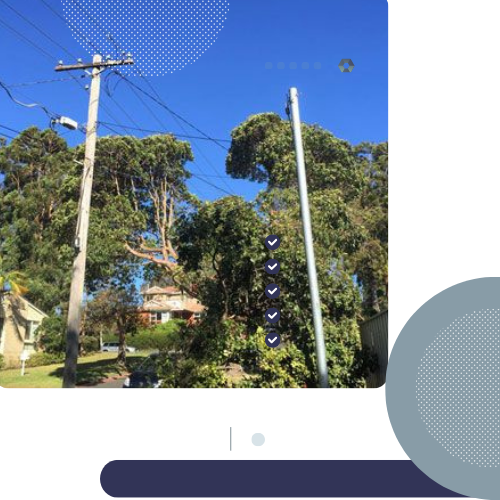Understanding Private Power Poles
Here’s a breakdown of private power poles:
What is a Private Power Pole?
- Typically required when your property is a significant distance from the existing power line.
- Ownership and maintenance responsibility usually lies with the property owner.
Why Would You Need One?
- Unique Property Configurations: Properties with unusual layouts or obstacles might require a private power pole for efficient power supply.
Installation Process:
- Safety Checks: The electrician ensures everything is working correctly and meets safety standards.
Additional Tips:
- Research reputable Level 2 electricians in your area.
- Get multiple quotes to compare prices and services.
- Ask about additional fees or permits.
- Ensure the electrician has insurance coverage.
Types of Private Power Poles
There are mainly three types of private power poles:
1. Timber Poles:
- Pros:
- Cost-effective
- Environmentally friendly
- Aesthetically pleasing
- Cons:
- Prone to rot and insect damage, especially in damp conditions
- Requires regular maintenance and treatment
- Limited lifespan compared to other materials
2. Galvanized Steel Poles:
- Pros:
- Require minimal maintenance
- Cons:
- More expensive than timber poles
- Can be susceptible to rust if not properly maintained
- Less aesthetically pleasing than timber poles
3. Concrete Poles:
- Pros:
- Require minimal maintenance
- Cons:
- Very heavy and difficult to install
- Less aesthetically pleasing than timber poles
- More expensive than timber or steel poles
Common Scenarios for Private Power Pole Installation:
- Remote Properties: Homes located far from existing power lines often necessitate private pole installations.
- New Developments: Subdivisions and rural properties may require individual poles to connect to the main power grid.
- Unique Property Configurations: Properties with specific layouts or obstacles might need custom pole installations.
Benefits and Challenges:
- Benefits:
- Ensures reliable power supply
- Provides flexibility for property layout and future expansions
- Can increase property value
- Challenges:
- Significant upfront costs
- Complex regulatory processes
- Ongoing maintenance requirements
Understanding the Process
1. Initial Consultation with the Electricity Distributor:
2. Hiring a Licensed Electrical Contractor:
3. Pole Installation and Connection:
Cost Considerations
The cost of a private power pole installation can vary significantly based on several factors:
- Pole Height and Material: Taller poles and specific materials can increase costs.
- Distance from the Main Power Line: Longer distances require more extensive wiring and may involve additional poles.
- Terrain and Accessibility: Difficult terrain can complicate installation and increase labor costs.
- Local Regulations and Permit Fees: Different regions may have varying regulations and fees.
Cost Breakdown:
- Material Costs: Poles, wires, hardware, and other components.
- Labor Costs: Technician fees for installation and connection
Additional Tips:
- Research reputable Level 2 electricians in Sydney and read reviews to find the best one for your project.
- Get multiple quotes to compare prices and services.
By following these steps and considering these factors, you can successfully complete your private power pole installation project in Sydney.




